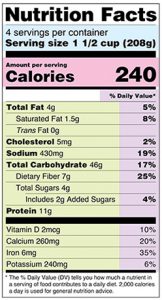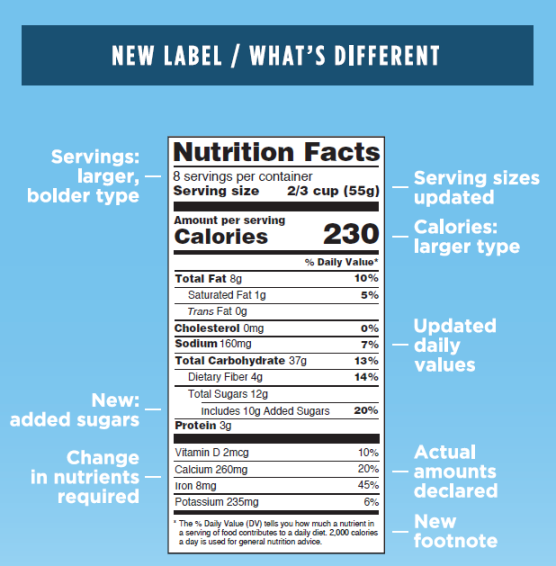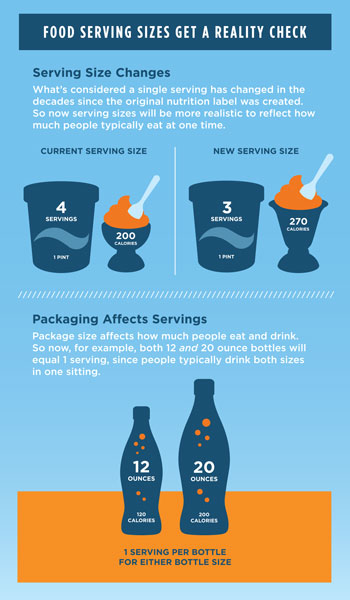2.6 – Discovering the Nutrition Facts Food Label
Learning Objective
- Be able to utilize nutrition facts labels to make decisions regarding foods to purchase and consume.
The Labels on Your Food
Understanding the significance of dietary guidelines and how to use D.R.I.s in planning your nutrient intakes can make you better equipped to select the right foods the next time you go to the supermarket. The Nutrition Facts food label is another essential tool to help consumers understand what is in the foods they eat.
In the United States, the Nutrition Labeling and Education Act passed in 1990 and came into effect in 1994. In Canada, mandatory labeling came into effect in 2005. As a result, all packaged foods sold in the United States and Canada must have nutrition labels that accurately reflect the contents and nutritional value of the food products. There are several mandated nutrients and some optional ones that manufacturers or packagers include.
In May 2016 a new Nutrition Facts label for packaged foods was announced. This label reflects new scientific information and will make it easier for consumers to make informed food choices. Some of the changes made to the label include:
- Increased type size for “Calories,” “servings per container,” and “Serving size”
- Bolded type for the number of calories and the “Serving size”
- Actual amounts of vitamin D, calcium, iron, and potassium (in addition to the Daily Value amounts) are required to be listed. Vitamins A and C are now voluntary.
- Improved footnote to better explain the Daily Value
- “Added sugars” in grams and percent Daily Value are required to be listed due to scientific data the impact of added sugars on caloric intake
- “Total Fat,” “Saturated Fat,” “Trans Fat,” “Cholesterol,” “Total Carbohydrates” are all still required on the label
- “Calories from fat” has been removed because the type of fat is important
- Updated values for calcium, sodium, dietary fiber, and vitamin D (which are all required on the label) based on newer scientific research
- Updated serving sizes that reflect how much consumers are more likely eating today
- Some packages with serving sizes between one and two are required to be labeled as one serving since most consumers will likely eat it in one sitting
- Dual columns for certain products that are larger than a single serving but could be consumed in one sitting will indicate “per serving” and “per package” amounts
- The compliance date for manufacturers to adopt the new label is January 1, 2020.
Reading the Label
The first part of the Nutrition Facts panel gives you information on the serving size and how many servings are in the container. For example, a label on a box of crackers might tell you that twenty crackers equal one serving and that the whole box contains 10 servings. All other values listed thereafter, from the calories to the dietary fiber, are based on this one serving. On the panel, the serving size is followed by the number of calories and then a list of selected nutrients.
percent Daily Value
You will also see “Percent Daily Value” on the far right-hand side. This helps you determine if the food is a good source of a particular nutrient or not. The Daily Value (D.V.) represents a reference amount of a given nutrient recommended per day based on a 2,000-kilocalorie diet. The Daily Value was developed and designed for food labels. The percentage of Daily Value (percent D.V.) represents the proportion of the total daily recommended amount that you will get from one serving of the food. For example, in the food label in Figure 2.6.2 the percent D.V. of calcium is 20 percent, which means that one serving of the food item provides 20 percent of the daily recommended calcium intake. Since the D.V. for calcium is 1,300 milligrams, the food producer determined the percent D.V. for calcium by taking the calcium content in milligrams in each serving, and dividing it by 1,300 milligrams, and then multiplying it by 100 to get it into percentage format. Whether you consume 2,000 calories per day or not you can still use the percent D.V. as a target reference.
A percent D.V. of 5 or less indicates that the food is considered low in that substance.
This means, as a general rule, for fat, saturated fat, trans fat, cholesterol, or sodium, look for foods with a low percent D.V.
A percent D.V. of 20 or more is considered high.
When concentrating on essential mineral or vitamin intakes, look for a high percent D.V.
To figure out your fat allowance remaining for the day after consuming one serving of the food below, look at the percent D.V. for fat, which is 5 percent, and subtract it from 100 percent. To know this amount in grams of fat, read the footnote of the food label to find that the recommended maximum amount of fat grams to consume per day for a 2,000 kilocalories per day diet is 65 grams. Five percent of sixty-five equals about 8 grams. This means that 57 grams of fat are remaining in your fat allowance. Remember, the recommendation for a healthy diet is to eat less than this amount of fat grams per day. This Daily Value article lists all of the daily values based on a reference intake for a 2,000 calories diet.

Figure 2.6.2 Nutrition Facts label
Of course, this is a lot of information to put on a label and some products are too small to accommodate it all. In the case of small packages, such as small containers of yogurt, candy, or fruit bars, permission has been granted to use an abbreviated version of the Nutrition Facts panel. To learn additional details about all of the information contained within the Nutrition Facts panel, see the following website.


There are other types of information that are required by law to appear somewhere on the consumer packaging. They include:
- Name and address of the manufacturer, packager, or distributor
- Statement of identity, what the product actually is
- Net contents of the package: weight, volume, measure, or numerical count
- Ingredients, listed in descending order by weight
When reading the ingredient list, the first ingredient is the ingredient that weighed the most or was the most predominant in the food. if you wanted to know which beef stew had more beef, you could look to the ingredient list to determine where beef fell in the list. If it is the first ingredient, you could be assured that there was quite a bit of beef in your stew. If beef is fourth on the list after water, potatoes, and carrots, it is likely that there is not much beef in the product.
The Nutrition Facts panel provides a wealth of information about the nutritional content of the product. The information also allows shoppers to compare products. Because the serving sizes are included on the label, you can see how much of each nutrient is in each serving to make the comparisons. Knowing how to read the label is important because of the way some foods are presented. For example, a bag of peanuts at the grocery store may seem like a healthy snack to eat on the way to class. But have a look at that label. Does it contain one serving or multiple servings? Unless you are buying the individual serving packages, chances are the bag you picked up is at least eight servings, if not more.
According to the 2014 health and diet survey released by the FDA, 79 percent of first-time buyers of a product will check the food label and will use this information to evaluate the nutrient contents of the product.1The survey also notes that more Americans are using food labels and are showing an increased awareness of the connection between diet and health. Having reliable food labels is a top priority of the FDA, which has a new initiative to prepare guidelines for the food industry to construct “front of package” labeling that will make it even easier for Americans to choose healthy foods. Stay tuned for the newest on food labeling by visiting the FDA website.
1 2014 F.D.A. Health and Diet Survey. U.S. Food and Drug Administration. Accessed June 18, 2019.
Claims on Labels
In addition to mandating nutrients and ingredients that must appear on food labels, any nutrient content claims must meet certain requirements. For example, a manufacturer cannot claim that a food is fat-free or low-fat if it is not, in reality, fat-free or low-fat. Low-fat indicates that the product has three or fewer grams of fat; low salt indicates there are fewer than 140 milligrams of sodium, and low-cholesterol indicates there are fewer than 20 milligrams of cholesterol and two grams of saturated fat. See Table 12.3 “Common Label Terms Defined” for some examples.
| Term | Explanation |
|---|---|
| Lean | Fewer than a set amount of grams of fat for that particular cut of meat |
| High | Contains more than 20% of the nutrient’s D.V. |
| Low | Contains less than 5 % of the nutrient’s D.V. |
| Reduced | Contains at least 25% less of the specific nutrient or calories compared to the original product. |
| Organic | Contains 95% organic ingredients |
Source: Gordon, B. The Basics of the Nutrition Facts Label. Academy of Nutrition and Dietetics. Published Dec. 8, 2017. Accessed June 18, 2019.
Health Claims
Often we hear news of a particular nutrient or food product that contributes to our health or may prevent disease. A health claim is a statement that links a particular food with a reduced risk of developing the disease. As such, health claims such as “reduces heart disease,” must be evaluated by the FDA before they may appear on packaging. Prior to the passage of the NLEA products that made such claims were categorized as drugs and not food. All health claims must be substantiated by scientific evidence in order for them to be approved and put on a food label. To avoid having companies making false claims, laws also regulate how health claims are presented on food packaging. In addition to the claim being backed up by scientific evidence, it may never claim to cure or treat the disease. For a detailed list of authorized health claims, visit this website.
Qualified Health Claims
While health claims must be backed up by hard scientific evidence, qualified health claims have supportive evidence, which is not as definitive as with health claims. The evidence may suggest that food or nutrient is beneficial. Wording for this type of claim may look like this: “Scientific evidence suggests, but does not prove, that whole grains (three servings or 48 grams per day), as part of a low saturated fat, low cholesterol diet, may reduce the risk of diabetes mellitus type 2.”2
2 F.D.A. Questions and Answers about Health Claims. Updated Dec 3, 2017. Accessed June 18, 2019.
Structure/Function Claims and Functional foods
Some companies claim that certain foods and nutrients have benefits for health even though no scientific evidence exists. In these cases, food labels are permitted to claim that you may benefit from the food because it may boost your immune system, for example. There may not be claims of diagnosis, cures, treatment, or disease prevention, and there must be a disclaimer that the FDA has not evaluated the claim.
Functional Foods (aka Superfoods) are foods that have positive effects on health beyond their basic nutrients. Unfortunately, there is no legal definition for these foods so manufacturers and marketing companies can use this label to promote their foods.
The Academy of Nutrition and Dietetics answer these questions, “Can…modified foods be considered functional foods? What is a functional food exactly?” on their website.
“To answer those questions, it’s helpful to remember that most foods are functional as they deliver physiological benefits including protein for muscle repair, carbohydrates for energy, or vitamins and minerals for cell function. But in the 1980s, the Japanese government created a class of “functional foods” — conventional and modified foods that included additional health benefits beyond basic nutrition. Although the U.S. Food and Drug Administration or FDA, regulates foods labeled as functional, it does not provide a legal definition of the term.
Functional foods cover a variety of foods, including whole foods along with fortified, enriched, or enhanced foods. Generally, they have a potentially beneficial effect on health when consumed on a regular basis at certain levels.
Functional foods may include:
- Conventional foods such as grains, fruits, vegetables, and nuts.
- Modified foods such as yogurt, cereals, and orange juice.3
3 Klemm, S. Functional Foods. Academy of Nutrition and Dietetics. Reviewed July 5, 2018. Accessed July 14, 2019.
Allergy Warnings
Food manufacturers are required by the F.D.A. to list on their packages if the product contains any of the eight most common ingredients that cause food allergies. These eight common allergens are as follows: milk, eggs, peanuts, tree nuts, fish, shellfish, soy, and wheat.
Under the FASTER Act of 2021, sesame is being added as the 9th major food allergen effective January 1, 2023. Until that time, manufacturers do not have to list it as an allergen, although in most cases it must appear in the ingredient statement. An exception is when sesame is part of a natural flavoring or spice. Another exception is when sesame is not in the common or usual name of a food (e.g., tahini, which is made from sesame seeds). In November 2020, to help consumers who are allergic or sensitive to sesame avoid these products, the FDA issued a draft guidance to encourage manufacturers to voluntarily declare sesame in the ingredient list when it is used as a “flavoring” or “spice” or when the common or usual name (such as tahini) does not specify sesame. The guidance is intended to help protect consumers who are allergic to sesame by encouraging manufacturers to identify all ingredients that contain sesame right now.4
More information on these allergens will be discussed in Chapter 9 “Energy Balance and Body Weight”.) The F.D.A. does not require warnings that cross-contamination may occur during packaging, however, most manufacturers include this advisory as a courtesy. For instance, you may notice a label that states, “This product is manufactured in a factory that also processes peanuts.” If you have food allergies, it is best to avoid products that may have been contaminated with the allergen.
4 https://www.fda.gov/food/food-labeling-nutrition/food-allergies
Key Takeaways
- The Nutrition Labeling and Education Act made it a law that foods sold in the United States have a food label that provides the accurate contents of nutrients within them. Canada has a similar law.
- A Nutrition Facts panel gives information on the number of servings per container, the number of calories per serving, and the amounts of certain nutrients.
- The percent DV is the percentage of the amount of the nutrient in the food in relation to its recommended intake. It is a guide to help you determine if a food is a good or poor source of nutrients.
- To keep companies from making false claims, the FDA provides regulations for food manufacturers in putting labels on packages that promote health. Allergens must also be listed on food labels. Sometimes cross-contamination does occur during packaging. Most food manufacturers voluntarily list this information. If you have a food allergy, it is best to avoid any product that has even had the possibility of coming in contact with a known allergen.
Discussion Starter
- Recall the food you buy from the supermarket on a regular basis. How many of the food products you purchase regularly are nutrient-dense? How many are nutrient-poor? What foods can you substitute in place of the nutrient-poor food choices?
Contributors
University of Hawai’i at Mānoa Food Science and Human Nutrition Program: Allison Calabrese, Cheryl Gibby, Billy Meinke, Marie Kainoa Fialkowski Revilla, and Alan Titchenal

